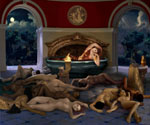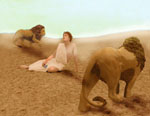Olga Tobreluts. Emperor and Galilean (sketches, graphics).
 Booklet. Co-organized with the State Russian Museum (St. Petersburg, Russia) and Oslo Contemporary Art Museum (Norway). …The fact that it was Olga Tobreluts who was offered by the Norwegian part to create a series of pictures dedicated to Ibsen’s jubilee may well be regarded casual. However, the manner of Tobreluts’ performance in this series and its congruence — in scale, feeling and thought — with Ibsen’s initial design shows certain necessity. First of all, Tobreluts understands her historical time as the time of change… A narrower context has been defined by the local situation in art. Here, the problematics of historicity has been formulated aesthetically as «neoacademism», the New Cult of Beauty and, finally, the New Russian Classicism.
Booklet. Co-organized with the State Russian Museum (St. Petersburg, Russia) and Oslo Contemporary Art Museum (Norway). …The fact that it was Olga Tobreluts who was offered by the Norwegian part to create a series of pictures dedicated to Ibsen’s jubilee may well be regarded casual. However, the manner of Tobreluts’ performance in this series and its congruence — in scale, feeling and thought — with Ibsen’s initial design shows certain necessity. First of all, Tobreluts understands her historical time as the time of change… A narrower context has been defined by the local situation in art. Here, the problematics of historicity has been formulated aesthetically as «neoacademism», the New Cult of Beauty and, finally, the New Russian Classicism.  Timur Novikov, St. Petersburg artist and theoretician, was the leader of this new movement and this movement happened to exert the formative influence on Olga Tobreluts’ professional development… O. Tobreluts created her stylistics on the basis of somewhat controversial and unpopular — though historically authentic — aesthetic material, namely the gesture pathetic and articulated «corporality» of the late academism coupled with the dense imagery of the Northern symbolism and pre-symbolism… However, Olga Tobreluts employs the sources of different nature. On one hand, it is camera culture and the resources of photo-media, on the other – expensive Hollywood historical dramas on ancient themes of the Ridley Scott’s Gladiator type. The artist’s attitude to these sources is very selective and pragmatic. With regard to photo-media, Tobreluts makes use of the work with negatives and emulsions. She uses the photo-media effects to render the states of epiphany, prophet dreams, and any transitional and extreme state in general. From movies she takes the effects of hypermonumental backgrounds and angle shots (Slain by Light, The Bowman) and the light and color special effects (for example, in the diptych Doom of the Fleet on Tigris one picture is made, as it were, in natural color whereas the other maintains a dramatic conflict of colors in order to create the atmosphere of imminent catastrophe – the fleet is set on fire by Julian). Neither Academism nor modern media effects are imitated here. Rather, they are used as sources: the artist avoids the mimicry either to the beauish «ma238;treness» and the compositional predetermination of the first or to the enforced optical distinctness and the verisimilitude of the second. Creating her own language — the language of the series — the artist primarily articulates its conditioned and somewhat artificial character and emphasizes its deliberate na239;vit233;. This is a deliberate contrivance or, rather, a metaphor. A metaphor of the good old theatricality of the end of the 19th century, with its bulky machinery, tin scenery, and artificial lightning. A metaphor of the good old belief (perhaps not so na239;ve) in the wholesome commotion of the spirits, agonizing suspense and elevating deceptions.
Timur Novikov, St. Petersburg artist and theoretician, was the leader of this new movement and this movement happened to exert the formative influence on Olga Tobreluts’ professional development… O. Tobreluts created her stylistics on the basis of somewhat controversial and unpopular — though historically authentic — aesthetic material, namely the gesture pathetic and articulated «corporality» of the late academism coupled with the dense imagery of the Northern symbolism and pre-symbolism… However, Olga Tobreluts employs the sources of different nature. On one hand, it is camera culture and the resources of photo-media, on the other – expensive Hollywood historical dramas on ancient themes of the Ridley Scott’s Gladiator type. The artist’s attitude to these sources is very selective and pragmatic. With regard to photo-media, Tobreluts makes use of the work with negatives and emulsions. She uses the photo-media effects to render the states of epiphany, prophet dreams, and any transitional and extreme state in general. From movies she takes the effects of hypermonumental backgrounds and angle shots (Slain by Light, The Bowman) and the light and color special effects (for example, in the diptych Doom of the Fleet on Tigris one picture is made, as it were, in natural color whereas the other maintains a dramatic conflict of colors in order to create the atmosphere of imminent catastrophe – the fleet is set on fire by Julian). Neither Academism nor modern media effects are imitated here. Rather, they are used as sources: the artist avoids the mimicry either to the beauish «ma238;treness» and the compositional predetermination of the first or to the enforced optical distinctness and the verisimilitude of the second. Creating her own language — the language of the series — the artist primarily articulates its conditioned and somewhat artificial character and emphasizes its deliberate na239;vit233;. This is a deliberate contrivance or, rather, a metaphor. A metaphor of the good old theatricality of the end of the 19th century, with its bulky machinery, tin scenery, and artificial lightning. A metaphor of the good old belief (perhaps not so na239;ve) in the wholesome commotion of the spirits, agonizing suspense and elevating deceptions.
Alexander Borovsky